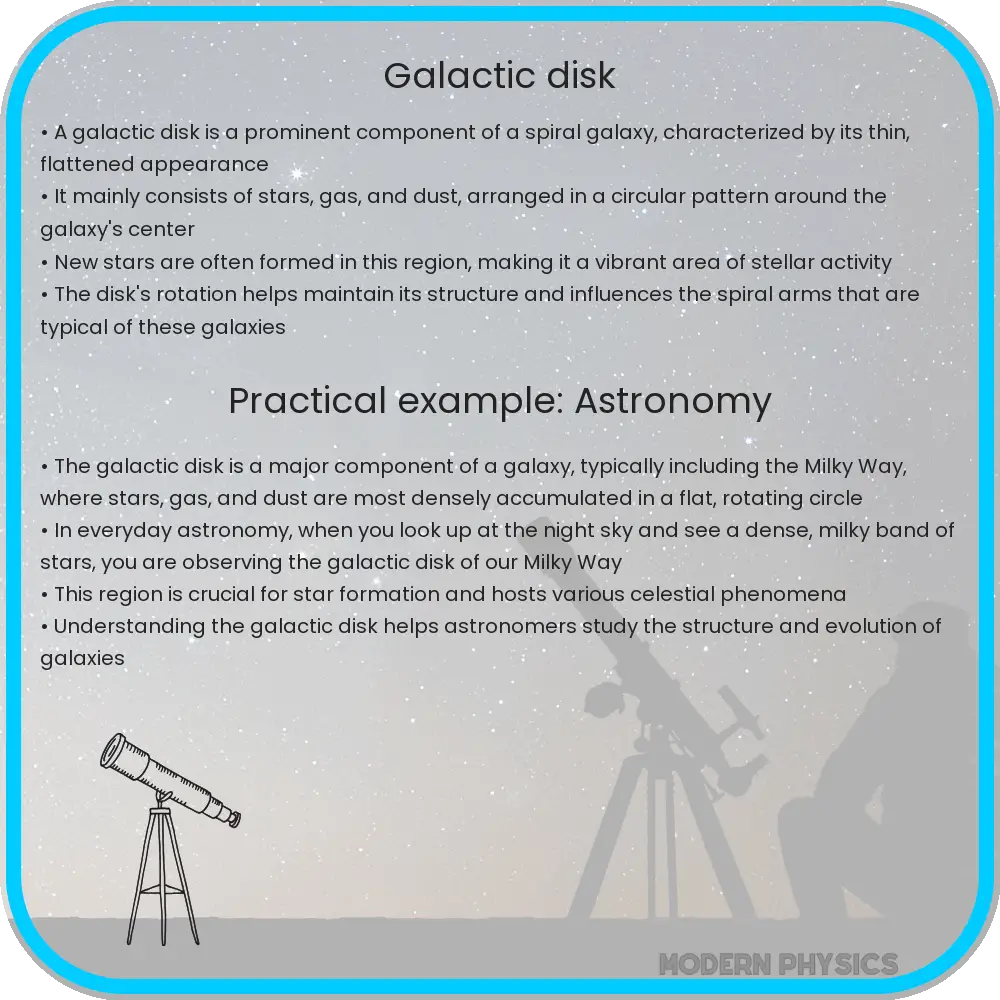Explore the mysteries of galactic disk formation, evolution, and dynamics, and how they shape the structure and history of galaxies like our Milky Way.

Galactic Disk Formation: Understanding the Cosmos
The formation and evolution of galactic disks are fundamental components in the study of astrophysics, offering insights into the dynamics and structure of galaxies. This article delves into the processes and mechanisms behind galactic disk formation, its evolution, and the intricate dynamics that govern these celestial bodies.
Early Stages of Galactic Disk Formation
The genesis of galactic disks is closely tied to the broader context of galaxy formation, beginning with the collapse of massive clouds of gas and dark matter in the early universe. This process, predominantly driven by the gravitational pull, leads to the birth of a protogalactic disk. As the cloud collapses, angular momentum is conserved, causing the gas to spin faster and flatten into a disk shape. This phase is critical in setting the stage for the subsequent formation of stars and planetary systems.
Structural Components of Galactic Disks
A typical galactic disk consists of several key components: the thin disk, the thick disk, and the stellar halo. The thin disk, characterized by young stars, gas, and dust, is the site of active star formation. In contrast, the thick disk contains older stars with higher velocities perpendicular to the plane of the galaxy. Surrounding these disks is the stellar halo, composed of the oldest stars, globular clusters, and dark matter.
Evolution and Dynamics
Galactic disks are dynamic entities, evolving over billions of years. Star formation, supernova explosions, and interactions with other galaxies contribute to this evolution. These processes not only influence the chemical composition and structure of the disk but also drive the migration of stars between the thin and thick disks. Moreover, the dynamics of galactic disks are governed by factors such as spiral arm formation, bar structures, and dark matter distribution, which play crucial roles in shaping the overall morphology and rotation curves of galaxies.
Understanding the formation, structure, and dynamics of galactic disks is not only essential for astrophysics but also for comprehending the history and future of our own Milky Way. The study of these celestial phenomena continues to challenge and expand our knowledge of the universe.
Chemical and Kinematic Properties of Galactic Disks
The chemical composition of galactic disks reveals crucial information about their history and evolution. Elements heavier than hydrogen and helium, known as metals in astronomical terms, are primarily forged in the cores of stars and distributed throughout the galaxy by supernova explosions. This process, termed galactic chemical evolution, results in metal-rich stars in the inner regions and metal-poor stars in the outer regions. Observing these metallicity gradients within galactic disks helps astronomers trace the star formation history and the mixing processes within the galaxy.
Interaction with the Environment
Galactic disks do not exist in isolation but continually interact with their surroundings. These interactions can take the form of accretion of small satellite galaxies, mergers with other galaxies, and gas inflow from the intergalactic medium. Such events can significantly alter the structure and dynamics of galactic disks, leading to phenomena such as the triggering of new star formation, the creation of tidal tails, and the thickening of the disk. The ability of a galaxy to accrete gas and its interaction with the environment are vital in determining its long-term evolution and star-forming activity.
Future Perspectives and Observations
Advancements in telescope technology and observational techniques continue to shed light on the mysteries of galactic disk formation and evolution. Missions like the Hubble Space Telescope, the Gaia satellite, and the upcoming James Webb Space Telescope provide unprecedented views of the universe, allowing for detailed studies of galactic structures across different wavelengths. These observations promise to unravel the complexities of galactic dynamics, chemical composition, and interaction with the cosmic environment.
Conclusion
The study of galactic disk formation, structure, and dynamics is a cornerstone of modern astrophysics, offering insights into the life cycles of galaxies and the cosmic forces that shape them. From the conservation of angular momentum in collapsing gas clouds to the intricate dance of stars and dark matter, the evolution of galactic disks is a testament to the dynamic nature of the universe. As we continue to explore the cosmos, the knowledge gained not only enlightens us about our own galaxy’s past and future but also connects us to the vast, unfolding story of the universe.
